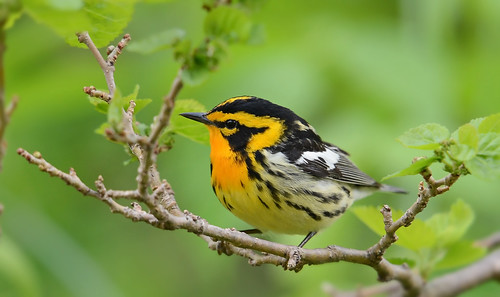Millions of birds will fly over the Great Lakes region this spring as they migrate north to their summer breeding grounds, but many populations of bird species are declining and in peril, according to ornithology experts at The Nature Conservancy (TNC).

Black throated blue warbler
Matt Williams, TNC’s director of conservation in Indiana, writes in his book Endangered and Disappearing Species of the Midwest that in the past 50 years alone, more than one-third of our bird species have declined by at least 15 percent, with many suffering declines of more than 70 percent. In total, these declines add up to a loss of 1.5 billion individual birds in just five decades.
Williams said the population decline of numerous bird species is caused by loss of habitat to agriculture and energy expansion, collisions with vehicles and structures, encounters with feral cats, changing forest conditions and climate change.
TNC’s associate director for Michigan, Dr. Patrick Doran, is an expert, lifelong birder and is highly active on social media sites like Twitter to share his sightings of #BackyardBirds with others. He noted that by identifying birds, it strengthens our connection to our natural world, and ultimately our care and concern for protecting nature.

Blackburnian warbler
“Birds are so much more than just checkmarks on a birder’s life list,” Doran said. “They’re beautiful to watch, make music for our ears and provide benefits to all of us.”
In addition to providing natural benefits, such as eating millions of insects, dispersing seeds, and pollinating crops, birds are big business to the Great Lakes, too. Birdwatchers spend an estimated $80 billion annually on cameras, binoculars, travel, and other hobby-related expenses.
TNC staff around the Great Lakes have worked together for decades to research, prioritize, and protect priority habitat for birds to rest and refuel during their long migration in the spring and fall. The coastal wetland complexes along Lake Erie near the Ohio border are especially inviting, given their location between agricultural lands in the northwest part of the state and the vast open-water expanse of Lake Erie. Here, migratory birds find safe habitat rich with forage, allowing them to replenish their depleted energy reserves and continue their migration.

Loggerhead Shrike
“Our Erie Marsh Preserve provides high-quality habitat for a variety of raptors, waterfowl, and other birds,” Doran said. “This is part of a network of preserves to give birds places to rest and refuel on their migration path.”
Historically one of the most extensive and productive coastal wetland complexes in the Great Lakes, over the past two centuries more than 95 percent of wetlands have been lost in southern Great Lakes, greatly reducing the area’s biological productivity, diversity, and resilience. TNC is protecting important habitat throughout the Great Lakes region through land acquisition, restoration, improved habitat management and more.
Doran noted that International Migratory Bird Day is May 9, giving people the chance worldwide to celebrate this twice-annual travel time for birds.
For more information and to see pictures, click here for Backyard Birding!

Blue Winged Teal at Eagle Marsh
The Nature Conservancy is a global conservation organization dedicated to conserving the lands and waters on which all life depends. Guided by science, TNC works to create innovative, on-the-ground solutions to the world’s toughest challenges so that nature and people can thrive together. Learn more online about TNC’s work to protect habitat for migratory birds in the Great Lakes region at nature.org/greatlakesbirds.
All photos courtesy and copyright Matt Williams, published with permission.
